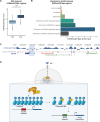Growth factor-induced activation of MSK2 leads to phosphorylation of H3K9me2S10 and corresponding changes in gene expression
- PMID: 38478612
- PMCID: PMC10936876
- DOI: 10.1126/sciadv.adm9518
Growth factor-induced activation of MSK2 leads to phosphorylation of H3K9me2S10 and corresponding changes in gene expression
Abstract
Extracellular signals are transmitted through kinase cascades to modulate gene expression, but it remains unclear how epigenetic changes regulate this response. Here, we provide evidence that growth factor-stimulated changes in the transcript levels of many responsive genes are accompanied by increases in histone phosphorylation levels, specifically at histone H3 serine-10 when the adjacent lysine-9 is dimethylated (H3K9me2S10). Imaging and proteomic approaches show that epidermal growth factor (EGF) stimulation results in H3K9me2S10 phosphorylation, which occurs in genomic regions enriched for regulatory enhancers of EGF-responsive genes. We also demonstrate that the EGF-induced increase in H3K9me2S10ph is dependent on the nuclear kinase MSK2, and this subset of EGF-induced genes is dependent on MSK2 for transcription. Together, our work indicates that growth factor-induced changes in chromatin state can mediate the activation of downstream genes.
Figures




Similar articles
-
The kinases MSK1 and MSK2 are required for epidermal growth factor-induced, but not tumor necrosis factor-induced, histone H3 Ser10 phosphorylation.J Biol Chem. 2006 May 5;281(18):12521-5. doi: 10.1074/jbc.M513333200. Epub 2006 Mar 3. J Biol Chem. 2006. PMID: 16517600
-
Phosphorylation of histone H3 serine 28 modulates RNA polymerase III-dependent transcription.Oncogene. 2011 Sep 15;30(37):3943-52. doi: 10.1038/onc.2011.105. Epub 2011 Apr 4. Oncogene. 2011. PMID: 21460852 Free PMC article.
-
IkappaB kinase alpha and p65/RelA contribute to optimal epidermal growth factor-induced c-fos gene expression independent of IkappaBalpha degradation.J Biol Chem. 2004 Jul 23;279(30):31183-9. doi: 10.1074/jbc.M404380200. Epub 2004 May 20. J Biol Chem. 2004. PMID: 15155743
-
MSK1 and MSK2 mediate mitogen- and stress-induced phosphorylation of histone H3: a controversy resolved.Sci STKE. 2003 Aug 12;2003(195):PE33. doi: 10.1126/stke.2003.195.pe33. Sci STKE. 2003. PMID: 12915720 Review.
-
Histone H3 phosphorylation - a versatile chromatin modification for different occasions.Biochimie. 2012 Nov;94(11):2193-201. doi: 10.1016/j.biochi.2012.04.018. Epub 2012 Apr 28. Biochimie. 2012. PMID: 22564826 Free PMC article. Review.
References
-
- Mahadevan L. C., Willis A. C., Barratt M. J., Rapid histone H3 phosphorylation in response to growth factors, phorbol esters, okadaic acid, and protein synthesis inhibitors. Cell 65, 775–783 (1991). - PubMed
-
- Haws S. A., Yu D., Ye C., Wille C. K., Nguyen L. C., Krautkramer K. A., Tomasiewicz J. L., Yang S. E., Miller B. R., Liu W. H., Igarashi K., Sridharan R., Tu B. P., Cryns V. L., Lamming D. W., Denu J. M., Methyl-metabolite depletion elicits adaptive responses to support heterochromatin stability and epigenetic persistence. Mol. Cell 78, 210–223.e8 (2020). - PMC - PubMed
Publication types
MeSH terms
Substances
Grants and funding
LinkOut - more resources
Full Text Sources
Molecular Biology Databases

